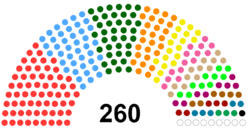House of the People (Kertosono): Difference between revisions
(Created page with "{{Infobox legislature | name = House of the People | native_name = ꦒꦿꦶꦪꦫꦏꦾꦠ꧀ <br> <br> Griyå Rakyat | native_name_lang = | transcription_name = | legislat...") |
No edit summary |
||
| Line 110: | Line 110: | ||
| seats8_title = <!-- up to | seats10_title = --> | | seats8_title = <!-- up to | seats10_title = --> | ||
| seats8 = <!-- up to | seats10 = --> | | seats8 = <!-- up to | seats10 = --> | ||
| voting_system1 = | | voting_system1 = {{wp|Multiple non-transferable Vote}} <br> {{wp|First pass the post}} | ||
| voting_system2 = | | voting_system2 = | ||
| first_election1 = | | first_election1 = | ||
| first_election2 = | | first_election2 = | ||
| first_election3 = | | first_election3 = | ||
| last_election1 = | | last_election1 = 29 April 2018 | ||
| last_election2 = | | last_election2 = | ||
| last_election3 = | | last_election3 = | ||
| next_election1 = | | next_election1 = Before 1 June 2022 | ||
| next_election2 = | | next_election2 = | ||
| next_election3 = | | next_election3 = | ||
| Line 126: | Line 126: | ||
| session_res = | | session_res = | ||
| session_alt = | | session_alt = | ||
| meeting_place = | | meeting_place = Palace of the Parliament, Ngawi | ||
| session_room2 = | | session_room2 = | ||
| session_res2 = | | session_res2 = | ||
| Line 140: | Line 140: | ||
| footnotes = | | footnotes = | ||
}} | }} | ||
The '''House of the People''' (Kertic: ꦒꦿꦶꦪꦫꦏꦾꦠ꧀ ''"Griyå Rakyat"'') is the {{wp|lower house}} of the {{wp|parliament|Dewan Rakyat}}, the parliament of [[Kertosono]]. It is the {{wp|elected}} chamber of the parliament, and is the primary house of the Dewan Rakyat. Together with the unelected upper house, the ''Griyå Sesepuh'' or House of Elders, it executes a legislative function at the national level as enshrined in the 1901 constitution and subsequent laws passed by the parliament regarding the legislative bodies of Kertosono and its functions. As a {{wp|federation}}, the powers of the House of the People are somewhat more limited compared to other parliaments in {{wp|unitary states}}, focusing mainly on {{wp|fiscal}} matters, defense, foreign policy, and other issues or matters at hand deemed to be important at the national level. | |||
Comprised of 260 members, most of whom are members of a {{wp|political party}}, are elected using {{wp|electoral districts}}. The individual method of voting differs between districts depending on how many representatives a district sends. Electoral districts which only send one representative to parliament use the {{wp|first past the post}} method, while all others use {{wp|multiple non-transferable vote}}. Each term lasts four years, and {{wp|term limits}} for the House of the People have been abolished since 1975. | |||
The current House of the People is a continuation of the Pan-Kertic Consultative Assembly established in 1873 by the Pan-Kertic Confederation aimed at easing relations and trade between the splintered Kertic states. It was unified with the newly-created House of Elders in 1901 to create the parliament of Kertosono as a compromise between the common people and the nobility. Prior to the unification of the legislatures in 1901, most independent entities of Kertosono had their own legislatures or {{wp|advisory boards}} with varying degrees of directly-elected representatives, though most still had purely unelected legislatures, mostly coming from noble families or appointed by the monarch themselves. The idea of a bicameral parliament was first inspired by the Banyumasan legislature which had separate houses to represent the common people and the nobility. | |||
Originally, the House of the People had equal footing with the House of Elders in an act of {{wp|perfect bicameralism}}. Growing aspirations and calls for the lessening of royal or noble authority in the legislature prompted several reforms in the Dewan Rakyat. In 1958, the House of Elders was stripped off many of its powers, favoring the House of the People and thus making it the primary house in parliament, operating within the bounds of an {{wp|imperfect bicameralism|imperfect bicameral}} system. | |||
Revision as of 03:44, 28 January 2022
House of the People ꦒꦿꦶꦪꦫꦏꦾꦠ꧀ Griyå Rakyat | |
|---|---|
| 38th parliament | |
 Logo of the Griyå Rakyat | |
| Type | |
| Type | Lower house of the Dewan Rakyat |
Term limits | 4 years |
| History | |
| Founded | 1902 |
| Leadership | |
President | Agung Sucahyo, PRK Since 15 July 2018 |
Vice president | Subandi Wiyogo, PKM Since 15 July 2018 |
Vice president | Arioseno president, UN Since 15 July 2018 |
Vice president | Rusminah, SIK Since 15 July 2018 |
Prime minister | Sulistyono Raharjo, PRK Since 12 August 1998 |
Leader of the opposition | Hartanto Yulistyono, PKM Since 9 February 2017 |
| Structure | |
 | |
Political groups | Government coalition
Opposition
Neutral
|
| Elections | |
| Multiple non-transferable Vote First pass the post | |
Last election | 29 April 2018 |
Next election | Before 1 June 2022 |
| Meeting place | |
| Palace of the Parliament, Ngawi | |
The House of the People (Kertic: ꦒꦿꦶꦪꦫꦏꦾꦠ꧀ "Griyå Rakyat") is the lower house of the Dewan Rakyat, the parliament of Kertosono. It is the elected chamber of the parliament, and is the primary house of the Dewan Rakyat. Together with the unelected upper house, the Griyå Sesepuh or House of Elders, it executes a legislative function at the national level as enshrined in the 1901 constitution and subsequent laws passed by the parliament regarding the legislative bodies of Kertosono and its functions. As a federation, the powers of the House of the People are somewhat more limited compared to other parliaments in unitary states, focusing mainly on fiscal matters, defense, foreign policy, and other issues or matters at hand deemed to be important at the national level.
Comprised of 260 members, most of whom are members of a political party, are elected using electoral districts. The individual method of voting differs between districts depending on how many representatives a district sends. Electoral districts which only send one representative to parliament use the first past the post method, while all others use multiple non-transferable vote. Each term lasts four years, and term limits for the House of the People have been abolished since 1975.
The current House of the People is a continuation of the Pan-Kertic Consultative Assembly established in 1873 by the Pan-Kertic Confederation aimed at easing relations and trade between the splintered Kertic states. It was unified with the newly-created House of Elders in 1901 to create the parliament of Kertosono as a compromise between the common people and the nobility. Prior to the unification of the legislatures in 1901, most independent entities of Kertosono had their own legislatures or advisory boards with varying degrees of directly-elected representatives, though most still had purely unelected legislatures, mostly coming from noble families or appointed by the monarch themselves. The idea of a bicameral parliament was first inspired by the Banyumasan legislature which had separate houses to represent the common people and the nobility.
Originally, the House of the People had equal footing with the House of Elders in an act of perfect bicameralism. Growing aspirations and calls for the lessening of royal or noble authority in the legislature prompted several reforms in the Dewan Rakyat. In 1958, the House of Elders was stripped off many of its powers, favoring the House of the People and thus making it the primary house in parliament, operating within the bounds of an imperfect bicameral system.